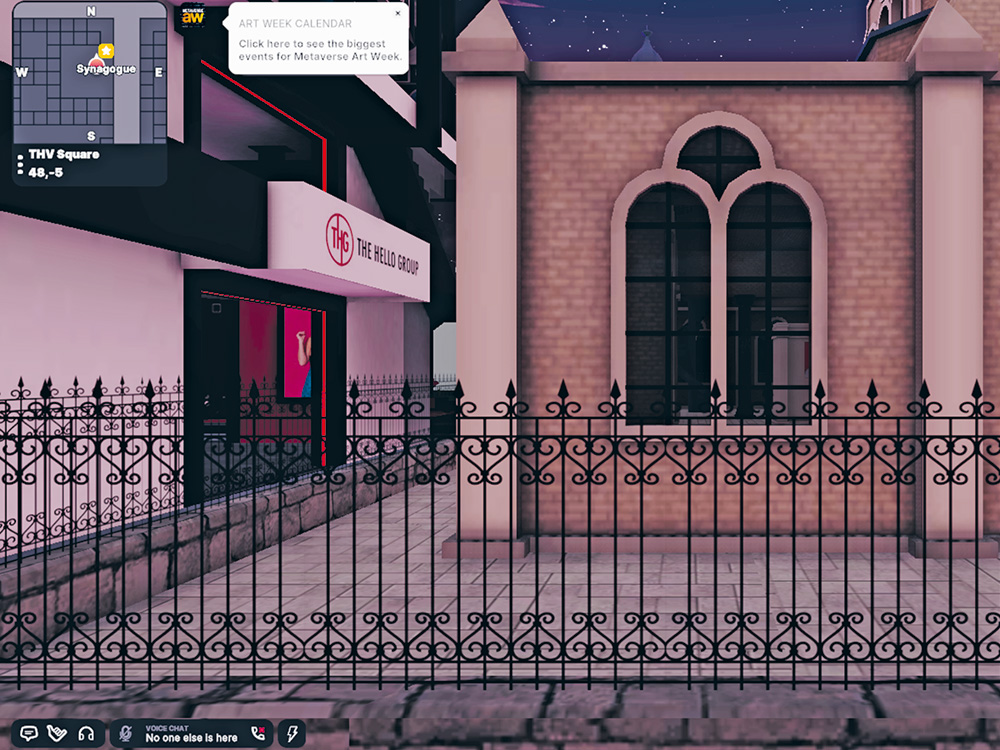Who rules the metaverse?
Text: Eva Wolfangel
When social media creates virtual realities, many artifacts of the material world play out there. A voyage into a possible future of social media shows what this might look like.
It all starts with a friendly greeting: “Welcome to Decentraland! Create, explore and trade in the first-ever virtual world owned by its users! Lose yourself in an amazing, evolving world. Buy and sell LAND, Estates, Avatar wearables and names in the Decentraland Marketplace.”
Time to dive in. Anyone who wants to visit Decentraland can simply choose an avatar–and in just a few clicks, you are standing in the middle of the Plaza, the heart of Genesis City, where you are encouraged to take a look around. Then the text disappears. On one side, you see a cozy bench, on the other, a billboard with events, and in the center is a pool with a sign inviting you to take a dip.
Three-dimensional and immersive
According to Fabian Schär, the world of Decentraland could be the first step toward the metaverse. Fabian Schär, Professor of Distributed Ledger Technology and Fintech at the University of Basel, is convinced that the social networks of the future will be three-dimensional and immersive, and that people will spend more and more time in virtual worlds: This will give rise to the metaverse, a multi-platform virtual reality universe that we can visit using headsets, computers or mobile devices. “It will no longer revolve around a single application–the driving force will be the social nature of the metaverse and its links to a range of applications,” says Schär.
According to Schär, whether or not we personally consider it a worthwhile pursuit to relocate our social lives to a virtual world is not the central question: Regardless of individual preference, many trends suggest that networks are indeed developing in that direction. “So, users have to understand the potential risks they are exposed to,” warns Schär.
Following the announcement by Facebook CEO Mark Zuckerberg, many were concerned: He had not only invested millions in the futuristic technology, he had also renamed his company “Meta”, an unambiguous statement of his intent for the company to play a leading role in this virtual future. Both specialists and users of existing virtual 3D worlds agree that it is not a good idea for a single company to have power over our future social and economic interactions–and most certainly not a company that has designed its two-dimensional social network, Facebook, in such a way as to allow hate speech and fake news to become a major force on the platform.
In the future, many people will earn a living in the metaverse, they will found companies and invest money, they will sell products and even hold events. So, what started as a simple gimmick could grow to become a platform with an economic impact comparable to that of a small to medium-sized country. But what if all of that was controlled by a major corporation? “This would introduce severe dependencies and create a monopoly,” explains Schär. The company would have the power to change the rules of the game in the virtual world and interfere in the economy.
By contrast, Decentraland is– as its name suggests–organized decentrally. It does not belong to a company but is owned by its users. Users vote on the rules of their virtual world, and the entire system is organized and managed using a blockchain. The intent is to inhibit the formation of a monopoly and prevent a single corporation or individual from taking control of the virtual world on their own.
Taking a walk through Decentraland
When you visit Decentraland, you can go anywhere the spirit takes you and discover all manner of amusing curiosities. The graphics could still use some improvement in places, but you can imagine a future in which spaces like these are filled with life; you can envision taking a virtual stroll with friends or even going to a party. If you want to leave Genesis Plaza, you can either walk, using your mouse or different key combinations to control your avatar, or you can click on a map. A bird’s-eye view of the terrain reveals that this world is designed based on a checkerboard pattern. When you enter, you land at Genesis Plaza, which is located at the coordinates, 0,0.
Strolling through the world, you might encounter an enormous fence surrounding a synagogue, for instance. A few more steps and you reach THV Square, home to a company known as THV, which has clearly purchased the rights to both the property and its name. Just beyond that is a streetcar, and if you manage to hop onboard, you can take a tour through the future. Mountains, meadows, colorful shrubs and expanses of open land–that is, until you reach a station with a Vodafone store, complete with all of the usual posters advertising phone contracts and online games. Unfortunately, there are no other people there.
The store’s location right next to the streetcar is likely no coincidence: Ultimately, it means more people will see it, just like this journalist/tourist did today. Vodafone probably paid a small fortune for this lot. That was the conclusion of a new research paper by Fabian Schär and his colleagues Mitchell Goldberg and Peter Kugler: Land prices differ significantly and location matters, even in the metaverse.
Attention economy
It is a surprising discovery because in virtual worlds you can use teleportation to jump from one place to another with a single click. Travel costs nothing–not even time. It would follow, then, that location does not make a difference. But the attention economy holds just as much sway here as it does anywhere else: “Random encounters are important,” explains Schär. “That has a major impact, as everything is business-driven.” For their study, the research group evaluated the prices Decentraland users paid for different properties and found strong empirical evidence for these effects. Even in the initial auction, there were much higher bids for central locations, for example, near Genesis Plaza, as well as for properties with memorable coordinates. Today, there is already a secondary market on a separate website where this virtual real estate is bought and sold. “Two lots in a popular area,” advertises Dan#7492, who receives just short of 7000 dollars in the deal.
Seven thousand dollars for a virtual lot in Decentraland where you might randomly meet a grand total of three other avatars while out on a walk? “It’s disproportionate to the amount of activity there at the moment,” says Schär. “These are high-risk investments, and the pricing relies heavily on future expectations.” So, it’s clear that some people believe the metaverse could gain traction in the future. And although for most people, the term “metaverse” still sounds like science fiction, all signs seem to indicate that it is poised to change our lives significantly.
More articles in the current issue of UNI NOVA.



